《市场营销学》课程PPT教学课件(双语)Chapter 07 Pricing Strategies
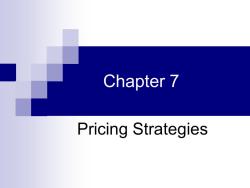
Chapter 7 Pricing Strategies
Chapter 7 Pricing Strategies
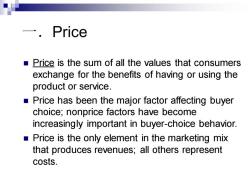
一.Price Price is the sum of all the values that consumers exchange for the benefits of having or using the product or service. Price has been the major factor affecting buyer choice;nonprice factors have become increasingly important in buyer-choice behavior. Price is the only element in the marketing mix that produces revenues;all others represent costs
一.Price ◼ Price is the sum of all the values that consumers exchange for the benefits of having or using the product or service. ◼ Price has been the major factor affecting buyer choice; nonprice factors have become increasingly important in buyer-choice behavior. ◼ Price is the only element in the marketing mix that produces revenues; all others represent costs
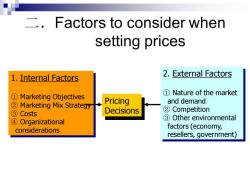
Factors to consider when setting prices 1.Internal Factors 2.External Factors D Marketing Objectives ①Nature of the market 2 Marketing Mix Strategy Pricing and demand ③Costs Decisions ②Competition ③Other environmental ④Organizational considerations factors (economy, resellers,government)
二.Factors to consider when setting prices 1. Internal Factors ① Marketing Objectives ② Marketing Mix Strategy ③ Costs ④ Organizational considerations 2. External Factors ① Nature of the market and demand ② Competition ③ Other environmental factors (economy, resellers, government) Pricing Decisions
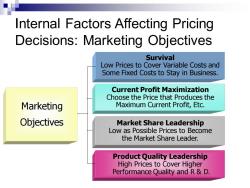
Internal Factors Affecting Pricing Decisions:Marketing Objectives Survival Low Prices to Cover Variable Costs and Some Fixed Costs to Stay in Business. Current Profit Maximization Choose the Price that Produces the Marketing Maximum Current Profit,Etc. Objectives Market Share Leadership Low as Possible Prices to Become the Market Share Leader. Product Quality Leadership High Prices to Cover Higher Performance Quality and R&D
Marketing Objectives Survival Low Prices to Cover Variable Costs and Some Fixed Costs to Stay in Business. Current Profit Maximization Choose the Price that Produces the Maximum Current Profit, Etc. Market Share Leadership Low as Possible Prices to Become the Market Share Leader. Product Quality Leadership High Prices to Cover Higher Performance Quality and R & D. Internal Factors Affecting Pricing Decisions: Marketing Objectives
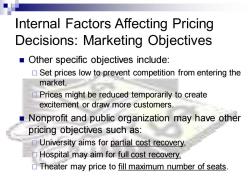
Internal Factors Affecting Pricing Decisions:Marketing Objectives Other specific objectives include: Set prices low to prevent competition from entering the market, Prices might be reduced temporarily to create excitement or draw more customers. Nonprofit and public organization may have other pricing objectives such as: University aims for partial cost recovery, Hospital may aim for full cost recovery, Theater may price to fill maximum number of seats
Internal Factors Affecting Pricing Decisions: Marketing Objectives ◼ Other specific objectives include: Set prices low to prevent competition from entering the market, Prices might be reduced temporarily to create excitement or draw more customers. ◼ Nonprofit and public organization may have other pricing objectives such as: University aims for partial cost recovery, Hospital may aim for full cost recovery, Theater may price to fill maximum number of seats

Internal Factors Affecting Pricing Decisions:Marketing Mix Customers Seek Produets that Give Them the Best value i Terms of Benetits Received forthe Price Paid Product Design Nonprice Distribution Positions Promotion
Price Product Design Distribution Promotion Nonprice Positions Internal Factors Affecting Pricing Decisions: Marketing Mix

Types of Cost Factors that Affect Pricing Decisions Fixed Costs Variable Costs (Overhead) Costs that don't Costs that do vary vary with sales or directly with the production levels. level of production. Executive Salaries,Rent Raw materials Total Costs Sum of the Fixed and Variable Costs for a Given Level of Production
Types of Cost Factors that Affect Pricing Decisions Total Costs Sum of the Fixed and Variable Costs for a Given Level of Production Variable Costs Costs that do vary directly with the level of production. Raw materials Fixed Costs (Overhead) Costs that don’t vary with sales or production levels. Executive Salaries, Rent

Costs Considerations Cost Per Unit at Different Levels of Production Per Period SRAC LRAC Quantity Produced per Day
Costs Considerations Cost per unit 1 2 3 4 SRAC LRAC Quantity Produced per Day 1,000 2,000 3,000 4,000 Cost Per Unit at Different Levels of Production Per Period
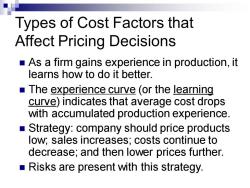
Types of Cost Factors that Affect Pricing Decisions As a firm gains experience in production,it learns how to do it better. The experience curve (or the learning curve)indicates that average cost drops with accumulated production experience. Strategy:company should price products low;sales increases;costs continue to decrease;and then lower prices further. Risks are present with this strategy
Types of Cost Factors that Affect Pricing Decisions ◼ As a firm gains experience in production, it learns how to do it better. ◼ The experience curve (or the learning curve) indicates that average cost drops with accumulated production experience. ◼ Strategy: company should price products low; sales increases; costs continue to decrease; and then lower prices further. ◼ Risks are present with this strategy
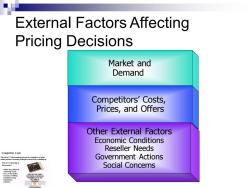
External Factors Affecting Pricing Decisions Market and Demand Competitors'Costs, Prices,and Offers Other External Factors Economic Conditions Reseller Needs Competitor Costs Government Actions Social Concerns
Market and Demand Competitors’ Costs, Prices, and Offers Other External Factors Economic Conditions Reseller Needs Government Actions Social Concerns External Factors Affecting Pricing Decisions Competitor Costs This ad by LCI International accuses its competitors of using unfair practices in pricing, hiding fees incurred by rounding up. Hidden fees, defined as “cramming” by the FCC, are the number one source of billing complaints among long-distance customers. Why is LCI focusing on this practice?
按次数下载不扣除下载券;
注册用户24小时内重复下载只扣除一次;
顺序:VIP每日次数-->可用次数-->下载券;
- 《市场营销学》课程PPT教学课件(双语)Chapter 08 Marketing Channels and Supply Chain Management.ppt
- 内蒙古科技大学:《市场营销学》课程PPT教学课件(中文)第3章 营销系统与营销环境分析.ppt
- 内蒙古科技大学:《市场营销学》课程PPT教学课件(中文)第1章 营销与营销过程(主讲教师:梅蕾).ppt
- 内蒙古科技大学:《市场营销学》课程PPT教学课件(中文)第4章 消费者市场与购买行为分析.ppt
- 内蒙古科技大学:《市场营销学》课程PPT教学课件(中文)第2章 顾客价值与顾客满意.ppt
- 内蒙古科技大学:《市场营销学》课程PPT教学课件(中文)第5章 市场细分、决定目标市场与定位.ppt
- 内蒙古科技大学:《市场营销学》课程PPT教学课件(中文)第6章 产品决策.ppt
- 内蒙古科技大学:《市场营销学》课程PPT教学课件(中文)第9章 市场传播与促销.ppt
- 内蒙古科技大学:《市场营销学》课程PPT教学课件(中文)第8章 分销管理.ppt
- 内蒙古科技大学:《市场营销学》课程PPT教学课件(中文)第7章 价格策略.ppt
- 内蒙古科技大学:《市场营销学》课程PPT教学课件(中文)第10章 产品生命周期与营销战略.ppt
- 内蒙古科技大学:《市场营销学》课程作业习题(综合)综合习题二.doc
- 内蒙古科技大学:《市场营销学》课程作业习题(综合)综合习题一.doc
- 内蒙古科技大学:《市场营销学》课程作业习题(综合)综合习题二答案.doc
- 内蒙古科技大学:《市场营销学》课程作业习题(综合)综合习题一答案.doc
- 内蒙古科技大学:《市场营销学》课程作业习题(综合)综合习题三.doc
- 内蒙古科技大学:《市场营销学》课程作业习题(综合)综合习题三答案.doc
- 内蒙古科技大学:《市场营销学》课程作业习题(综合)综合习题四.doc
- 内蒙古科技大学:《市场营销学》课程作业习题(综合)综合习题四答案.doc
- 内蒙古科技大学:《市场营销学》课程作业习题(综合)综合习题五答案.doc
- 《市场营销学》课程PPT教学课件(双语)Chapter 09 Integrated Marketing Communication Strategy.ppt
- 《市场营销学》课程PPT教学课件(双语)Chapter 06 Product, Services and Branding Strategies.ppt
- 《市场营销学》课程PPT教学课件(双语)Chapter 05 Segmentation, Targeting, and Positioning.ppt
- 《市场营销学》课程PPT教学课件(双语)Chapter 02 Company and Marketing Strategy.ppt
- 《市场营销学》课程PPT教学课件(双语)Chapter 04 Consumer Markets and Consumer Buying Behavior.ppt
- 《市场营销学》课程PPT教学课件(双语)Chapter 03 The Marketing Environment.ppt
- 《市场营销学》课程PPT教学课件(双语)Chapter 01 Marketing - Managing Profitable Customer Relationships.ppt
- 《企业经营管理》课程教学大纲1/2.doc
- 《企业经营管理》课程教学大纲2/2.doc
- 《企业经营管理》课程教学资源(授课教案)第一章 现代企业与管理.doc
- 《企业经营管理》课程教学资源(授课教案)第三章 现代企业技术创新与产品开发.doc
- 《企业经营管理》课程教学资源(授课教案)第二章 现代企业组织与文化.doc
- 《企业经营管理》课程教学资源(授课教案)第六章 现代企业营销管理.doc
- 《企业经营管理》课程教学资源(授课教案)第七章 现代企业成本管理.doc
- 《企业经营管理》课程教学资源(授课教案)第四章 现代企业生产管理.doc
- 《企业经营管理》课程教学资源(授课教案)第五章 现代企业质量管理.doc
- 《企业经营管理》课程教学资源(授课教案)企业经营管理总复习.doc
- 《企业经营管理》课程教学课件(PPT讲稿)第一章 现代企业与管理.ppt
- 《企业经营管理》课程教学课件(PPT讲稿)第二章 现代企业组织与文化.ppt
- 《企业经营管理》课程教学课件(PPT讲稿)第三章 现代企业技术创新与产品开发.ppt
